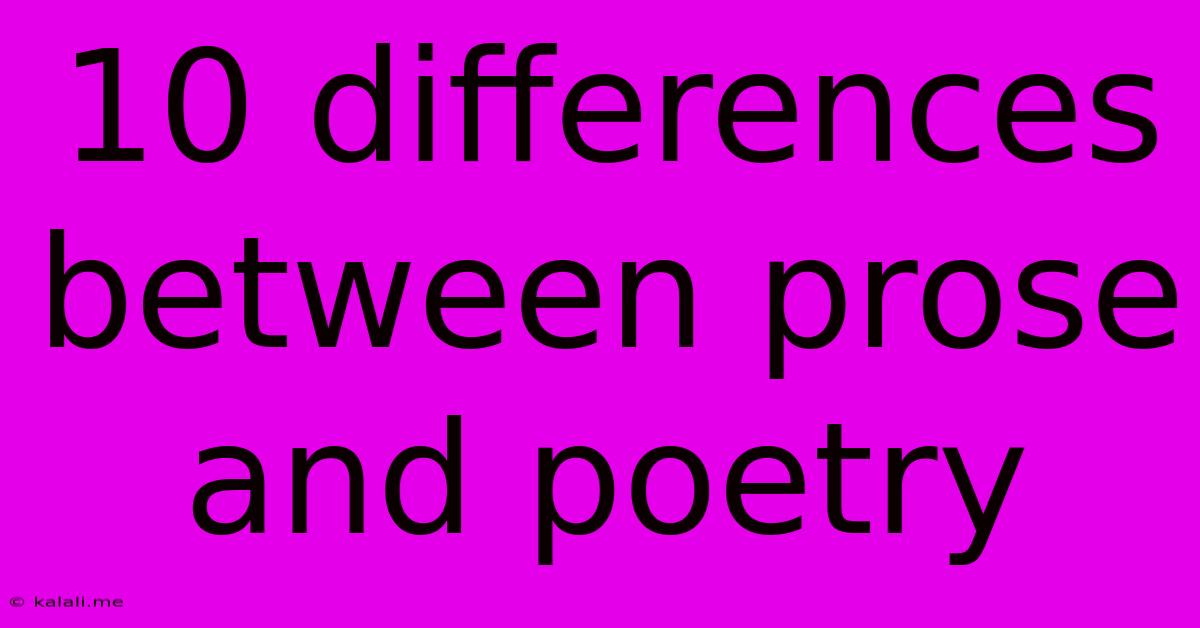10 Differences Between Prose And Poetry
Kalali
Jun 16, 2025 · 3 min read

Table of Contents
10 Key Differences Between Prose and Poetry: A Comparative Guide
Meta Description: Explore the fundamental distinctions between prose and poetry. This comprehensive guide outlines 10 key differences, clarifying their structures, styles, and purposes. Learn how to identify and appreciate the unique qualities of each literary form.
Prose and poetry, two cornerstones of literature, often appear vastly different at first glance. While both aim to communicate ideas and emotions, their approaches diverge significantly. This article illuminates ten key distinctions between prose and poetry, helping you understand and appreciate the unique characteristics of each. Understanding these differences will enhance your reading comprehension and writing skills, whether you're crafting a compelling novel or a poignant poem.
1. Structure and Form: The Foundation of Difference
Perhaps the most obvious distinction lies in their structure. Prose follows a grammatical structure typical of everyday speech and writing. It flows in sentences and paragraphs, adhering to conventional grammatical rules and punctuation. Poetry, on the other hand, prioritizes aesthetic form. It often employs specific structures like sonnets, haikus, or free verse, often manipulating line breaks and stanzas to create rhythm and visual impact.
2. Rhythm and Meter: The Musicality of Language
Prose generally lacks a consistent rhythmic pattern. The rhythm emerges naturally from the sentence structure and word choice. Poetry, however, often utilizes rhythmic patterns like iambic pentameter or trochaic tetrameter, creating a musicality that enhances the emotional impact. Meter, the structured arrangement of syllables in a line, is a key element in many poetic forms.
3. Rhyme and Sound Devices: The Art of Aurality
While not always present, rhyme is a common feature in poetry, contributing to its musicality and memorability. Poets also employ other sound devices like alliteration, assonance, and consonance to create pleasing auditory effects. Prose rarely employs these devices systematically, although they might appear incidentally for stylistic effect.
4. Line Breaks and Stanzas: Visual Organization
Poetry utilizes line breaks and stanzas to visually organize the text, impacting the pacing and emphasis of the piece. Line breaks can create pauses, build suspense, or highlight specific words. Prose, conversely, uses paragraphs to organize information, focusing primarily on the grammatical structure of sentences.
5. Figurative Language: Heightened Expression
Both prose and poetry employ figurative language, such as metaphors, similes, and personification. However, poetry often uses figurative language more densely and intensely, creating heightened imagery and emotional resonance. Prose may use figurative language more sparingly, focusing on clarity and direct communication.
6. Conciseness and Density: Economy of Words
Poetry often strives for concision, using few words to convey profound meaning. Each word carries significant weight and contributes to the overall impact. Prose allows for greater length and elaboration, explaining ideas in more detail.
7. Imagery and Sensory Details: Evoking Experience
Both forms aim to create vivid imagery, but poetry often uses more concentrated sensory details, appealing to the reader's sight, sound, smell, taste, and touch to evoke a powerful emotional response. Prose might also use imagery, but it may be less intensely focused and more integrated into the narrative.
8. Emotional Impact and Expression: The Power of Feeling
While both forms convey emotion, poetry often directly and intensely expresses feelings, aiming for a visceral and emotional connection with the reader. Prose might convey emotion through character development, narrative events, or descriptions, but its approach might be more indirect.
9. Purpose and Function: The Intent of the Writer
The intended purpose often differs. Poetry might prioritize aesthetic beauty, emotional expression, or exploring complex themes concisely. Prose, on the other hand, may aim to tell a story, inform, persuade, or analyze.
10. Interpretation and Ambiguity: Multiple Meanings
While both can be open to interpretation, poetry often embraces ambiguity, leaving room for multiple readings and individual responses. Prose, while capable of nuance, usually aims for greater clarity and direct communication of its intended meaning.
In conclusion, while both prose and poetry are valuable forms of literary expression, understanding their key differences helps appreciate the unique strengths and artistry of each. The distinctions in structure, rhythm, and purpose contribute to their distinct identities and lasting power in shaping our understanding of the world and ourselves.
Latest Posts
Latest Posts
-
How To Create Clickable Image In Html
Jun 16, 2025
-
What Are The Factors Of 121
Jun 16, 2025
-
What Is A Theme Of The Passage
Jun 16, 2025
-
A Company That Provides Access To The Internet
Jun 16, 2025
-
Which Word Is Closest In Meaning To The Underlined Word
Jun 16, 2025
Related Post
Thank you for visiting our website which covers about 10 Differences Between Prose And Poetry . We hope the information provided has been useful to you. Feel free to contact us if you have any questions or need further assistance. See you next time and don't miss to bookmark.